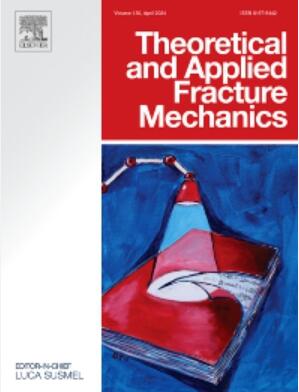Assessment of full-field J-integrals through digital image correlation using stress estimation based on measured strains
IF 5
2区 工程技术
Q1 ENGINEERING, MECHANICAL
引用次数: 0
Abstract
Application of digital image correlation (DIC) for full-field J-integral measurement with single-edge bending type SE(B) specimens, varying crack length-to-width ratios (a0/W), and a ductile material was studied numerically and experimentally. The specimens were first modelled in FEM and the displacement data was treated as measurement data to validate the method. Experimental studies were then conducted to extract full-field J-integrals by DIC. The study shows comparable or slightly higher J-values obtained with the surface DIC measurement as with the ASTM E1820 standard. However, there are certain considerations regarding convergence of the full-field J-integrals when large scale yielding and large rotations are involved.
The small strain theory behind J-integral imposes a limitation on the full-field method once the rotations are large enough to impose an error in the measured gradients. The rotations cause an inherent negative error in the measured gradients, which in turn imposes a negative error in the measured J. This is especially evident when the contour or domain for J-integral is taken far-field and contains areas that exhibit close to zero strains. A simple remedy is to determine the J-integral relatively close to the crack tip avoiding large rotations, while still also avoiding the crack tip to avoid strain localizations.
基于实测应变的应力估计,通过数字图像相关评估全场j积分
对单边弯曲型SE(B)试样、不同裂纹长宽比(a0/W)和延性材料进行了数值和实验研究,应用数字图像相关(DIC)技术对j积分进行了全方位测量。首先对试件进行有限元建模,并将位移数据作为测量数据进行验证。然后进行了用DIC提取全场j积分的实验研究。研究表明,表面DIC测量获得的j值与ASTM E1820标准相当或略高。但是,当涉及大尺度屈服和大旋转时,需要考虑全场j积分的收敛性。j积分背后的小应变理论对全场法施加了限制,一旦旋转大到足以在测量梯度中施加误差。旋转在测量的梯度中引起固有的负误差,这反过来又在测量的j中施加负误差。当j积分的轮廓或域是远场的并且包含表现出接近零应变的区域时,这一点尤其明显。一种简单的补救方法是确定相对靠近裂纹尖端的j积分,避免大的旋转,同时仍然避免裂纹尖端以避免应变局部化。
本文章由计算机程序翻译,如有差异,请以英文原文为准。
求助全文
约1分钟内获得全文
求助全文
来源期刊

Theoretical and Applied Fracture Mechanics
工程技术-工程:机械
CiteScore
8.40
自引率
18.90%
发文量
435
审稿时长
37 days
期刊介绍:
Theoretical and Applied Fracture Mechanics'' aims & scopes have been re-designed to cover both the theoretical, applied, and numerical aspects associated with those cracking related phenomena taking place, at a micro-, meso-, and macroscopic level, in materials/components/structures of any kind.
The journal aims to cover the cracking/mechanical behaviour of materials/components/structures in those situations involving both time-independent and time-dependent system of external forces/moments (such as, for instance, quasi-static, impulsive, impact, blasting, creep, contact, and fatigue loading). Since, under the above circumstances, the mechanical behaviour of cracked materials/components/structures is also affected by the environmental conditions, the journal would consider also those theoretical/experimental research works investigating the effect of external variables such as, for instance, the effect of corrosive environments as well as of high/low-temperature.
 求助内容:
求助内容: 应助结果提醒方式:
应助结果提醒方式:


